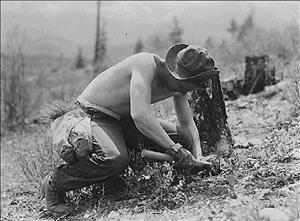On January 1, 1946, the Forest Practice Act requires Washington loggers to plant trees to replace the logs that they have harvested. The State Division of Forestry is empowered to enforce the provisions and a nine-member board will adopt rules to protect soils, water, fish, wildlife, and public capital improvements from the impacts of logging. Some timber interests oppose the statute and appeal its constitutionality to the United States Supreme Court. The court upholds the law.
As early as the turn of the twentieth century, U.S. Forest Service Director Giffort Pinchot predicted that the U.S. would face a "timber famine" (Sensel, 118) by 1940. Although some large timber owners were able to retain ownership of logged-off lands, the system of property taxes made it uneconomical to own land that was not immediately productive. Some landowners simply abandoned their holdings, which became state property. In 1933 and 1934, Congress tried to get logging companies to submit reforestation plans, but few complied. Most owners resented any governmental intrusion into the prerogatives of private property. Companies like Weyerhaeuser started tree farms where trees were planted instead of being allowed to grow by chance.
Governor Mon Wallgren (1891-1961) took office in January 1945 and he instructed the State Forester, T. S. Goodyear, to draft a reforestation law. The act's intent is to "tend to insure future forest growth" (WFFA Annual Report, 1946, 10). Timberland owners were required to take steps towards reforestation. A federal law passed in 1944 allowed federal and private lands to be combined for the purpose of forestry management.
Under the new law, any logger seeking a permit to cut timber had to agree to provide adequate reforestation. This applied to a private landowner cutting his own trees. Some timber owners took their case to court, but the U.S. Supreme Court held that the law was a valid exercise of state police powers.
The Forest Practice Act was replaced in 1974 by a new Forest Practices Act which provided a mechanism for more complex rulemaking to govern forestry.

